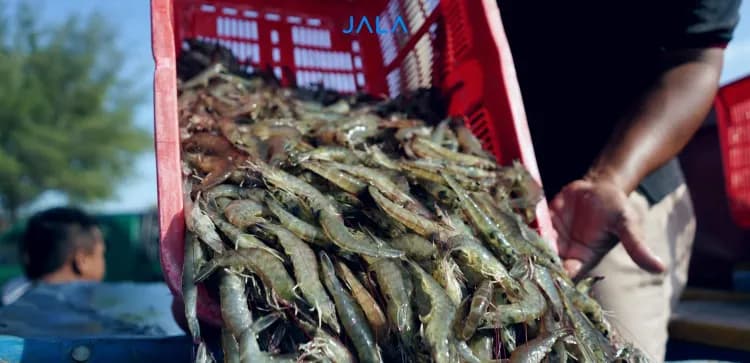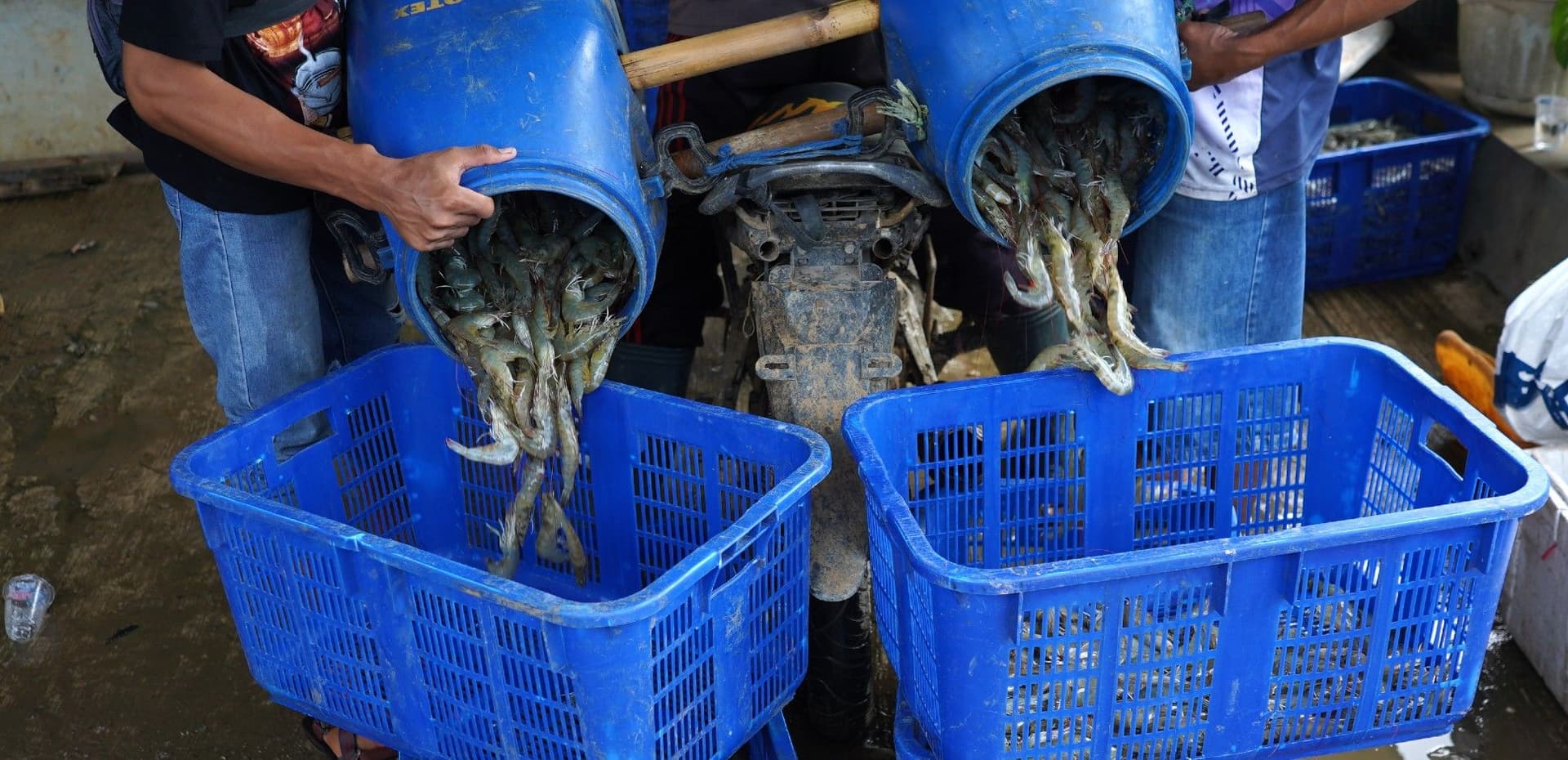
Shrimp farmers in Indonesia have faced extreme shrimp price decline at the end of 2022 (Read more: Check Out 2022 Shrimp Prices). Entering the second quarter of 2023, the unpleasant trend in shrimp prices seems to have made a comeback. Leaving the first half of 2023, shrimp prices for all sizes in several regions experience a decrease.
As cited from JALA App’s Shrimp Price feature (https://harga.jala.tech, shrimp prices reached their lowest point in 2023 after previously bouncing back from their 2022 condition.
Aceh and North Sumatera
Since June, shrimp prices in Aceh show a decrease in price. This decrease continued towards the end of June. Although shrimp prices in Aceh showed a positive trend in the second quarter at the beginning of April, they further dropped towards the end of June.
 Shrimp price trends in North Sumatera is quite similar to that in Aceh, with a continuous decrease from early to late June.
Shrimp price trends in North Sumatera is quite similar to that in Aceh, with a continuous decrease from early to late June.
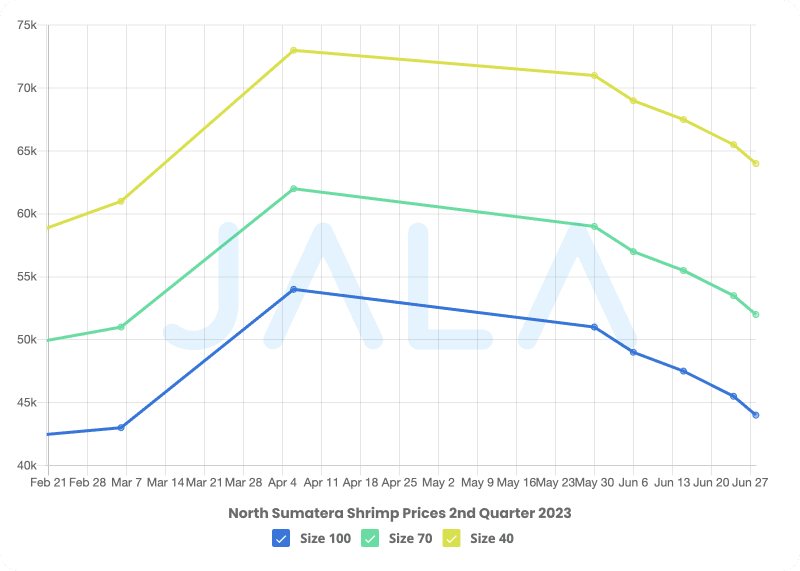
West Java
Although shrimp prices in West Java initially showed a positive fluctuation around April-May, the trend worsened towards the end of June for all shrimp sizes.
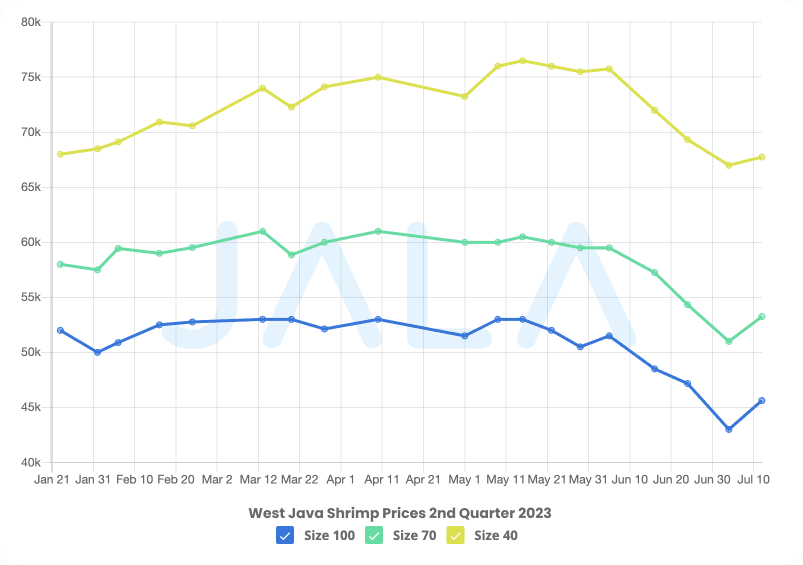
Central Java
The drop in shrimp prices for Central Java occurred during mid-June and further dropped towards late June. Shrimp prices for larger sizes experienced the steepest drop, and shrimp prices have reached their lowest point in 2023.
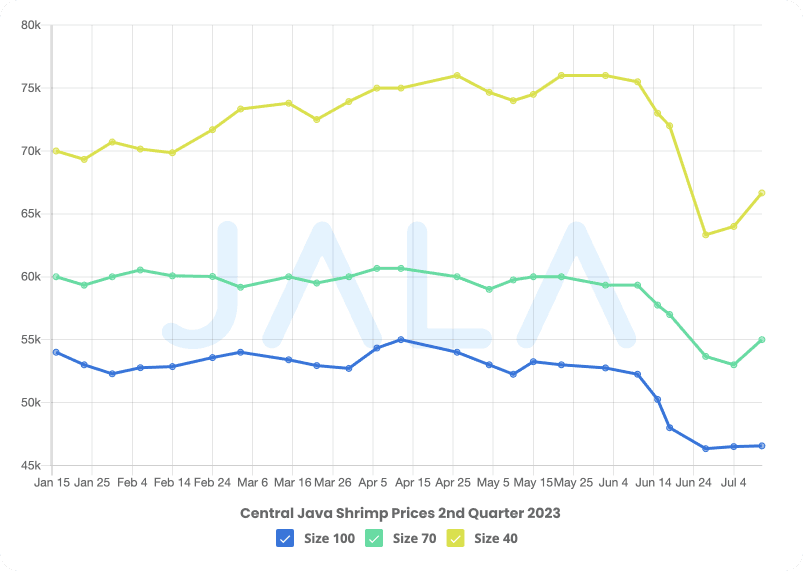
East Java
Shrimp price drops in East Java started in the third week of May. Entering June, the prices further dropped with a drastic freefall in late June. Similar to conditions in West and Central Java, East Java has now reached the lowest shrimp prices in 2023.
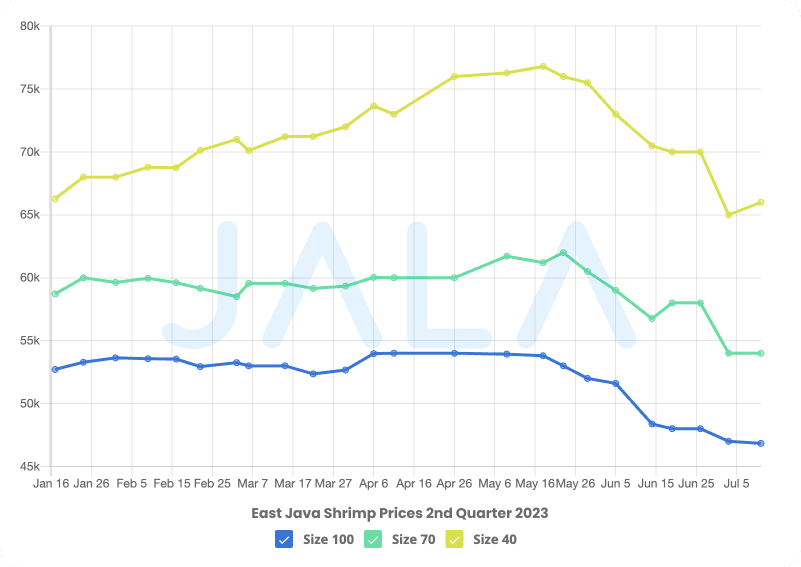
Bali and West Nusa Tenggara
Shrimp price trends in Bali and West Nusa Tenggara are similar to that of Java, with the decline beginning in mid-May. In Bali, the range in prices was higher than that in West Nusa Tenggara.
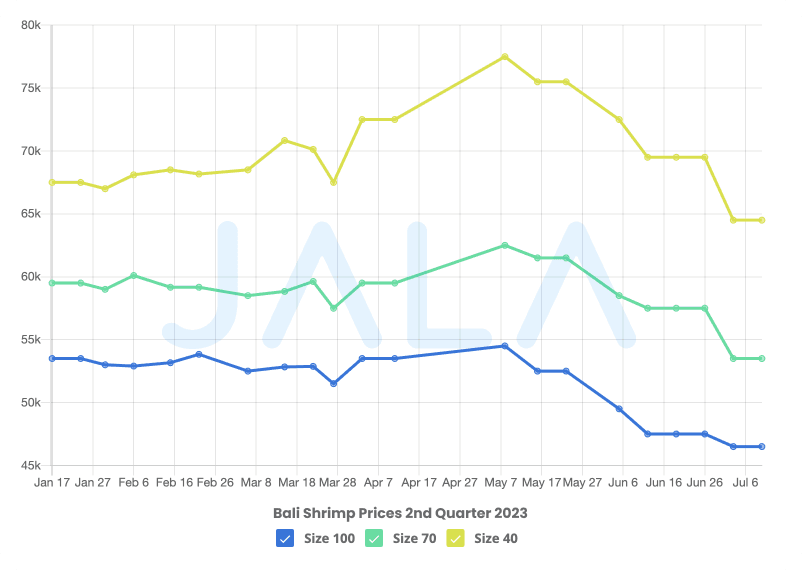 Shrimp price conditions in the two provinces experienced a brief stable condition, and even recovered in April for West Nusa Tenggara. Unfortunately, the prices dropped again in mid-May and continued decreasing towards the end of the second quarter.
Shrimp price conditions in the two provinces experienced a brief stable condition, and even recovered in April for West Nusa Tenggara. Unfortunately, the prices dropped again in mid-May and continued decreasing towards the end of the second quarter.
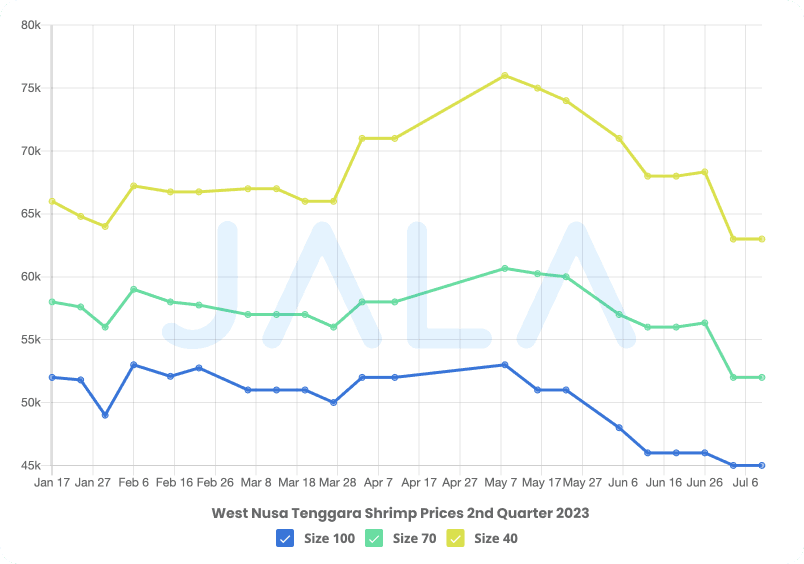
South Sulawesi
Shrimp price trends in South Sulawesi also showed a decrease. In the second quarter, prices briefly recovered in early May, but declined again from late May to early June.

Responding to the declining shrimp price trend
In the midst of declining shrimp prices, farmers are hoping or even desperate for the right step to take. At an industrial level, a collective collaboration is required from Indonesian industry players to improve the industry’s efficiency and increase product competitiveness. However, farmers can do their part in taking the following strategic steps.
Avoid panic harvest
Panic harvest was widespread among Indonesian farmers during the third and fourth quarter of 2022. This refers to the panic which causes farmers to harvest early as a response towards the declining shrimp prices, as they are worried about this trend. They anticipated that prices would keep dropping. However, this step caused shrimp prices at the supplier level to be further pressed. Panic harvest also occurred in India’s shrimp industry during the Covid-19 pandemic, which further decreased shrimp prices.
In the midst of decreasing shrimp prices, farmers should consider the right time to harvest. Some factors to consider are:
- Checking water quality stability
- Checking feeding trays or doing sampling to ensure size, biomass, health, and shrimp quality estimates
- Monitoring recent shrimp prices
- Finding shrimp buyers
Read more: When is the Best Time for Harvest?
Follow the latest shrimp price developments with JALA Harvest
Plan harvest thoroughly and monitor the most recent shrimp prices from credible off-takers with a good track record, such as JALA Harvest, which is JALA’s solution for farmers to harvest their cultivation. JALA Harvest has a wide network which spans in several cities/regencies in Java, Sumatera, Sulawesi, Bali, and West Nusa Tenggara Barat.
The cities/regencies that JALA Harvest can reach are East Lampung, South Lampung, Tanggamus, Pesawaran, Cirebon, Sukabumi, Cianjur, Tasikmalaya, Garut, Cilacap, Purworejo, Kebumen, Tegal, Kendal, Pemalang, Brebes, Purworejo, Bantul, Kulon Progo, Kebumen, Sumenep, Pasuruan, Tuban, West Nusa Tenggara, Bulukumba, Bantaeng, Barru, Jeneponto, Takalar, and Makassar.
Why harvest your shrimp with JALA Harvest?
- Quick and secure transaction
- Transparent and effective harvesting techniques which prioritize quality
- Harvesting team with a wide and flexible reach
Monitor the latest shrimp price trends through JALA’s Shrimp Price portal
To stay updated with the latest shrimp prices, farmers can monitor them directly from JALA’s shrimp price portal, which gathers prices from various regions and different harvest off-takers. This portal can be accessed through JALA App’s Shrimp Price section available through your web browser (PC/smartphone) or JALA App for mobile on your Android or iOS device.
There are some shrimp harvest off-takers that regularly update their price on JALA’s Shrimp Price portal for these two quarters in 2023. Get to know them:
Budi - PDS Supplier Area: Dompu, Sumbawa, West Lombok, Bali, Jember, Banyuwangi, Situbondo, and Probolinggo
Suwanno Area: Aceh and North Sumatera
Ali Roziqin Area: Kebumen, Jepara, Demak, Cilacap, Blitar, Probolinggo, Gresik, Malang, Pacitan, Lamongan, Kediri, Pamekasan, Pasuruan, Banyuwangi, Gianyar, Buleleng, East Lombok, and West Lombok
Hengky S Area: Cirebon, Sukabumi, Tasikmalaya, Pangandaran, Indramayu, Subang, Cianjur, Purwakarta, Garut, Pekalongan, Tegal, Semarang, Pemalang, Jepara, and Cilacap
Opick Ithem Area: Bondowoso, Tuban, Ponorogo, Probolinggo, Pasuruan, Pamekasan, Pacitan, Malang, Lamongan, Malang, Jember, Blitar, Banyuwangi, and Bangkalan
HeriParni Vanamai Area: Trenggalek and Pacitan
Ramdani Area: Jember and Probolinggo
Azis Area: East Lampung
Keenand Arkan Hadi Area: Sukabumi
Radifan Area: Makassar
Increase product value
Shrimp prices in Indonesia still heavily rely on the supply-demand condition from the global market due to depending on export markets. It’s time for Indonesia to improve product competitiveness and cultivation efficiency. Farmers can increase their product value by implementing sustainable cultivation or building processing facilities.
Product competitiveness can be increased by adding value to the products. This strategy is implemented by other shrimp-producing countries such as India. Due to their efforts, they successfully increased their added-value shrimp export numbers to 28% in 2022.
Process fresh ready-to-cook products
Added-value cultivation products can also be achieved by processing and packing them. This is part of JALA’s initiative to add value in shrimp cultivation products, leading JALA to bring fresh shrimp in frozen condition. With a wide network of shrimp farms and collaboration with processing companies, JALA produces frozen shrimp through a short distribution chain: harvest-process-deliver.
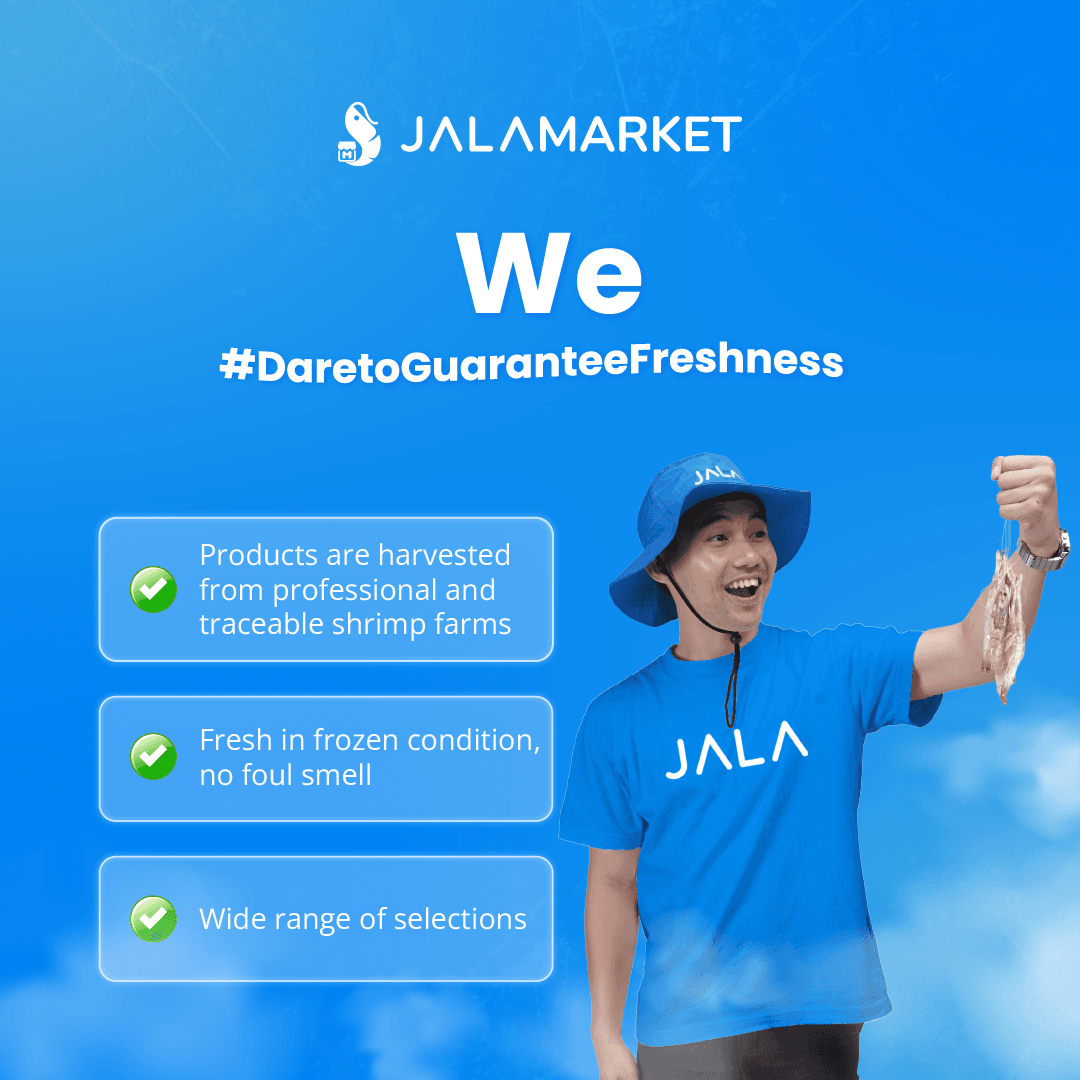 Harvested shrimp from the farm is processed in HACCP grade A and Halal-certified companies. Shrimp are distributed in frozen condition to maintain quality and freshness until they reach consumers. These shrimp products are suitable to supply the needs of hotels, restaurants, and catering, as well as for households. The product selections range from HOSO, PUD, and PDTO shrimp. Learn more at JALA Market.
Harvested shrimp from the farm is processed in HACCP grade A and Halal-certified companies. Shrimp are distributed in frozen condition to maintain quality and freshness until they reach consumers. These shrimp products are suitable to supply the needs of hotels, restaurants, and catering, as well as for households. The product selections range from HOSO, PUD, and PDTO shrimp. Learn more at JALA Market.
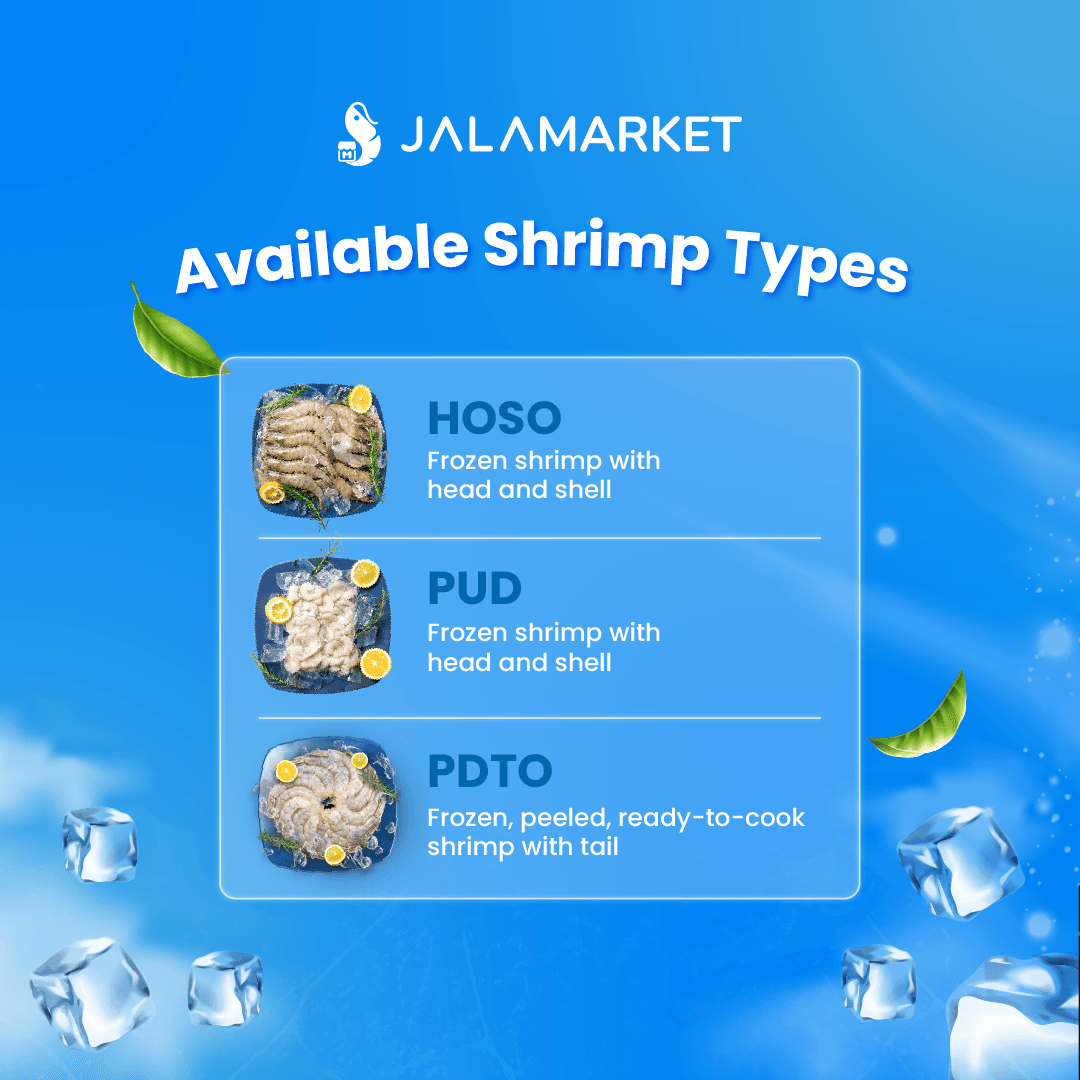
Increase cultivation efficiency and decrease stocking density
As cultivators, shrimp farmers can strive to eliminate various risks of cultivation failure, such as by managing water quality, implementing efficient feeding programs, and applying biosecurity measures. In the midst of an uncertain shrimp industry, risks also arise from business profitability.
Farmers need to determine cultivation targets that focus on profitability and cost efficiency. For example, when setting harvest size targets, determine them based on shrimp prices to surpass the break-even point. Targets can also refer to the duration of cultivation. Shorter durations are suitable for minimizing cultivation costs, but the maximum harvest size may not be reached. Longer durations can be oriented towards larger harvest sizes, but higher costs need to be prepared.
Cultivation level and stocking density are also factors that can be considered. The higher the cultivation level, such as implementing super-intensive methods, the higher the costs. This is also related to stocking density. Lower stocking densities result in lower production costs. Decreasing stocking density will decrease other costs such as feed and treatment costs. Meanwhile, higher stocking density increases the risk. Lowering stocking density decreases both risks and production costs. However, what is more important is ensuring that the cultivation is at an ideal carrying capacity.
Carrying capacity is the ability of the environment to sustain various activities of living organisms in a balanced manner. An ideal carrying capacity supports the life and growth of existing organisms. Also, the water quality will be stabilized, disease infection risks will be lowered, and shrimp will grow optimally. This should be done by maintaining environmental balance in the farm to ensure a sustainable and productive cultivation.
Learn more about carrying capacity: The Importance of Carrying Capacity in Shrimp Cultivation
Further considerations need to be taken based on current conditions. Remember that the price of larger shrimp sizes (size 40 and above) are at their lowest. Farmers should be wise in determining harvest targets at shrimp sizes with more stable prices.

